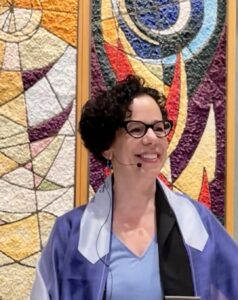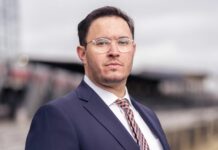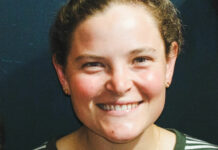Rabbi Rachel Sabath Beit- Halachmi’s love of Jewish peoplehood has influenced her whole life.

From the many years she lived in Israel to her current work at Har Sinai-Oheb Shalom Congregation as its inaugural senior rabbi, her deep engagement with Jewish texts, history, languages and culture has helped her bring people together and guide them on their Jewish journeys. Her professional experience in multidenominational and pluralistic endeavors in Reform, Conservative, Orthodox and nondenominational synagogues has given her a broad perspective on Jewish issues, informing her approach in the many leadership roles she has held throughout her life.
Sabath, 55, lives in Pikesville with her husband, their three Israeli-born children and their Yorkshire Terrier. In addition to her involvement at Har Sinai-Oheb Shalom Congregation, she is also an overseas member of a Jerusalem-based congregation where her husband, Rabbi Ofer Sabath Beit-Halachmi, was the rabbi while they lived in Israel.
Her love affair with Jewish history began when her father, a professor of medicine at Harvard University, gifted her a copy of “The Diary of a Young Girl” by Anne Frank. She had been raised in Reform congregations in Boston and Minneapolis and became a Hebrew speaker at a young age, but it was this book and a vow she later made when she visited the remains of the Treblinka extermination camp in Poland that cemented her commitment to Jewish work.
“My father gave me ‘The Diary of Anne Frank’ when I was 10 or 12 and said that this could have been him. He and Anne Frank have the exact same birthday,” Sabath said. “If his parents hadn’t come to the U.S. as immigrants from Ukraine, the Anne Frank story could have been him. Some of our family had died at Babi Yar,” she added, referring to the site in Kyiv where the Nazis murdered more than 100,000 Jews during the Holocaust.
When she visited Treblinka at 17, Sabath vowed to live her life as if she was one of the young women who did not get to live out their full lives because they were murdered in massacres or in concentration camps.
“What kept echoing in my ears from that moment was the idea that it could have been me but instead it was you, so I’ll keep doing the work you were doing as if I were two [people],” she said.
There were also many smaller factors that influenced her decision to become a rabbi, including her time at the Hebrew-speaking OSRUI (Olin Sang Ruby Union Institute) summer camp and the work of her childhood rabbis.
Sabath spent several years living in Israel, working at the Shalom Hartman Institute as its vice president and holding several positions at Hebrew Union College-Jewish Institute of Religion. She and her husband met in the U.S. and raised all three of their children in Israel, though they eventually moved back to the States primarily due to the health of her parents.
“We had always planned on spending a couple years in America to allow our kids to get to know their American grandparents, whom they didn’t share a language or much time with,” she explained. “And [HSOSC] was an incredible opportunity for me. I wanted to shift the focus of my career from being full-time academic and part-time congregational to full-time congregational and part-time academic. I really wanted to be able to serve a community.”
While HSOSC was far from the first congregation Sabath worked at, she described it as unique for being the “newest and oldest Reform congregation in North America” at the time. Har Sinai Congregation was established in 1842 as one of the first continuously Reform congregation in the U.S. The synagogue had just merged with Temple Oheb Shalom when Sabath became involved, leading her to become the combined congregation’s inaugural rabbi.
Sabath added that she felt a connection with the fledgling congregation because of Oheb Shalom’s first spiritual leader, Rabbi Benjamin Szold, and his daughter, Hadassah founder Henrietta Szold.
“I had actually written my undergraduate honors thesis about her, and my Ph.D. thesis was about the development of Reform theology,” she said. “I was attracted to both the entrepreneurial and communal opportunity of Har Sinai-Oheb Shalom, and also to its legacy and what it would mean in the 21st century.”
Part of Sabath’s work at HSOSC has involved better connecting it with Baltimore’s other Reform congregations. HSOSC often collaborates with Baltimore Hebrew Congregation and Bolton Street Synagogue on events, as well as synagogues in other denominations like The Soul Center at Beth El Congregation of Baltimore.
“I was a NFTY vice president for social action as a teenager, which is actually how I ended up on that trip to Poland at 17. I think that from that moment, I realized that we as a Jewish people are stronger when we interact with people from other denominations,” Sabath said. “And my work is very connected to my background as a committed pluralist.”
When she is not doing rabbinical work, Sabath works on the two books she is currently writing. The first focuses on the development of covenant theology among Jewish scholars, and the second — co-edited with Rabbi Rachel Adler, Hebrew Union College professor emerita of modern Jewish thought — is about Judaism and gender.
“Judaism is an evolving civilization evolving in all contexts, to develop and respond to new ways that we understand the world, whether it’s gender roles or climate awareness,” Sabath noted. “Obviously, the opportunity and challenge of having a sovereign Jewish democratic state is also a new phenomenon. What does that mean? And what does that mean in a post-Oct. 7 world? Jewish identity everywhere in the world is facing challenges, and at the same time, it is an incredible time of awakening and renewal.”







